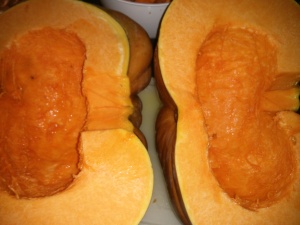I’ve done three more brew days since the one I talked about in my all grain post so I’d like to talk about them a bit. The first one of those was a pumpkin red ale.
Pumpkin Red Ale
The pumpkin red (which turned out a nice red colour) was the first time I tweaked a recipe, in which I didn’t actually tweak any of the original red ale recipe, but added pumpkin and pumpkin spices to it. The night before we brewed we cooked the pumpkin for an hour and a half, after which we scooped the insides out into a bowl and put it in the fridge overnight.

The next morning we put the pumpkin on a sheet and put it into the oven to roast until it started turning slightly brown. We then added it to our mash and proceeded as normal.
The spices we added were cinnamon, nutmeg and allspice, which we added at the last 5 minutes of the boil. The spices mostly add a strong pumpkin spice aroma, and not as much to the taste.
The pumpkin red ale is presently carbonating in a closet for another week and I will try it out next weekend.
American IPA and Dry-Hopping
We’ve also made an American IPA that involved dry hopping for the first time. We added the dry hops 7 days after making the initial beer, and on the morning of we were discussing how to put them in. In Sweden mesh bags to put bras in for the purpose of washing them are common, so we were able to attain one of those, boil it for a half hour (good thing, water was yellow after) and then thoroughly sterilize it before putting the hops in and adding it all to the bucket. We dry-hopped for 14 days and then bottled, it will be ready at the same time as the pumpkin red ale.
Bottling
Bottling has been a major learning curve for us. Our first beer we bottled we added our priming sugar, stirred gently to mix it around and promptly bottled. This resulted in wildly different levels of carbonation. We also ran into issues with sediment and air getting into the line resulting in a few bottles that were less than stellar tasting.
Our second bottling was similar, though at least we did wait a half hour for the priming sugar to mix in before we bottled the beer. Oxygen wasn’t as much an issue but sediment definitely was and we ended up spending a lot of time pumping the beer, which should not have been the case. That beer also ended up with nearly no carbonation and we’re not really sure why yet.
The third bottling was of the two beers I talked about above, and right now they are both sitting in a closet and we’ll know how things went for carbonation in a week. The bottling process however went much more smoothly. We got an extra bucket and racked the beer to the new bucket, removing almost all of the sediment from the batch. Once that was done we were able to bottle the whole batch with almost no issues, though we did have to pump the pump occasionally to keep the beer flow going. While I’m not sure about the pumpkin beer (I manned the pump for that one) the IPA (which I did the filling for) should have only one beer that had issues with oxygen – the first one I filled in the batch, and I know which bottle that is.

Leave a Reply